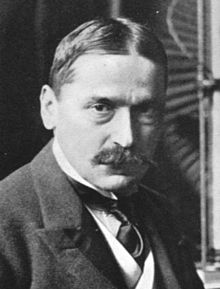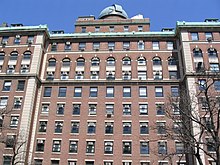Mihajlo Idvorski Pupin
Mihajlo Pupin ( Serbian - Cyrillic Михајло Идворски Пупин , Michael I. Pupin; born September 27 . Jul / 9. October 1854 greg. In Idvor in Pancevo in Banat , Empire of Austria ; † 12. March 1935 in New York , NY ) was a US- based physicist and writer from Serbia . The Pupin coil named after him and patented by him from 1894 enabled telephoning and sending telegrams over long distances.
education
Pupin immigrated to the United States from Austria-Hungary when he was 19. He worked for a number of years in the lower professions, for example in the cookie factory on Cortlandt Street in Manhattan . In 1879 he began to study at Columbia College , where he had a reputation as an excellent student and athlete. He graduated with honors in 1883 and also became an American citizen. He obtained his doctorate in Berlin under Hermann von Helmholtz . In 1889 he returned to New York and became professor of mathematical physics at the newly established Institute of Electrical Engineering at Columbia University . Among other things, he researched carrier wave rectification and current flow analysis.
Scientific work
In 1894 he patented the telephone cable structure , which is also known today as the Pupin cable (see coiled cable ). American Telephone and Telegraph (AT&T) bought the patent and made him a rich man. Pupin's patent was based on the foundational work done 7 years earlier by Oliver Heaviside , an English physicist and mathematician.
Pupin was one of the first to follow Röntgen's experiments on X-rays in the United States. In 1896 he invented the method of placing a sheet of paper coated with fluorescent substances next to the photographic plate, which reduced the exposure time for X-ray fluoroscopy from over an hour to a few seconds. He also conducted the first American study on the medical usability of X-rays. Shortly afterwards, in April 1896, he fell ill with pneumonia and almost died from it. His wife, who cared for him, became infected and died. He gave up research on X-rays after his recovery.
In 1901 he was appointed professor and in 1931 he retired. He lived in New York City and Norfolk , Connecticut , where he built a Serbian-style country house. In 1905 he was elected to both the American Academy of Arts and Sciences and the National Academy of Sciences . He received the Edison Medal in 1920 for his work on electrical engineering .
politics
In 1911 he was appointed Consul of the Kingdom of Serbia in the United States. In his address to Congress on January 8, 1918, President Woodrow Wilson , inspired by conversations with Pupin, called for the restoration of Serbia and Montenegro and autonomy for the peoples of the Austro-Hungarian Monarchy .
Books
Pupin's autobiography, From Immigrant to Inventor , won the Pulitzer Prize in 1924 ; a German translation appeared in 1929 under the title Vom Hirten zum Inventer . He also wrote The New Reformation (1927) and Romance of the Machine (1930) as well as various technical articles. The theme of much of his writings was his view that science supports and deepens belief in God. Pupin was active in the Serbian immigrant community in the USA and was the founder and first president of the Serbian National Defense Council of America . In 1918 he published a book on Serbian sacred monuments under the title Serbian Orthodox Church (Serbian Orthodox Church).
Patents
Pupin published over 70 technical articles in relevant journals and held over 30 patents.
| patent |
|---|
| Patent US519346 : Apparatus for telegraphic or telephonic transmission. Published May 8, 1894 . |
| Patent US519347 : Transformer for telegraphic, telephonic or other electrical systems. Published May 8, 1894 . |
| Patent US640515 : Art of distributing electrical energy by alternating currents. Published January 2, 1900 . |
| Patent US640516 : Electrical transmission by resonance circuits. Published January 2, 1900 . |
| Patent US652230 : Art of reducing attenuation of electrical waves and apparatus therefore. Published June 19, 1900 . |
| Patent US652231 : Method of reducing attenuation of electrical waves and apparatus therefore. Published June 19, 1900 . |
| Patent US697660 : Winding-machine. Published April 15, 1902 . |
| Patent US707007 : Multiple telegraphy. Published August 12, 1902 . |
| Patent US713044 : Producing asymmetrical currents from symmetrical alternating electromotive process. Published November 4, 1902 . |
| Patent US768301 : Wireless electrical signaling. Published 23 August 1904 . |
| Patent US761995 : Apparatus for reducing attenuation of electric waves. Published June 7, 1904 . |
| Patent US1334165 : Electric wave transmission. Published March 16, 1920 . |
| Patent US1336378 : Antenna with distributed positive resistance. Published April 6, 1920 . |
| Patent US1388877 : Sound generator. Published December 3, 1921 . |
| Patent US1388441 : Multiple antenna for electrical wave transmission. Published December 23, 1921 . |
| Patent US1415845 : Selective opposing impedance to received electrical oscillation. Published May 9, 1922 . |
| Patent US1416061 : Radio receiving system having high selectivity. Published May 10, 1922 . |
| Patent US1456909 : Wave conductor. Published May 29, 1922 . |
| Patent US1452833 : Selective amplifying apparatus. Published April 24, 1923 . |
| Patent US1446769 : Aperiodic pilot conductor. Published February 23, 1923 . |
| Patent US1488514 : Selective amplifying apparatus. Published April 1, 1923 . |
| Patent US1494803 : Electrical tuning. Published May 29, 1923 . |
| Patent US1503875 : Tone producing radio receiver. Published April 29, 1923 . |
Private life
He had four brothers and five sisters. After emigrating to the USA, he changed his name to Michael Idvorsky Pupin and in 1888 married the American Sarah Catharine Jackson from New York, with whom he had a daughter. His wife died of pneumonia in 1896 . Pupin died in 1935 and was buried in Woodlawn Cemetery , Bronx , New York City.
Honors
The lunar crater Pupin , the asteroid (57868) Pupin and the building of the physics faculty at Columbia University in New York, the Pupin Physics Laboratories , also known as Pupin Hall , are named after him. In Darmstadt there is a path named after him, the Pupinweg. In 2014, the Mihajlo-Pupin Bridge was opened in the west of Belgrade on the occasion of a China-Central-East-Europe summit .
literature
- J. Braunbeck: Pupin Michael Idvorsky. In: Austrian Biographical Lexicon 1815–1950 (ÖBL). Volume 8, Verlag der Österreichischen Akademie der Wissenschaften, Vienna 1983, ISBN 3-7001-0187-2 , p. 336 f. (Direct links on p. 336 , p. 337 ).
- Michael Idvorsky Pupin: From Immigrant to Inventor . Charles Scribner's sons, New York, London, 1923 (English, archive.org [PDF]).
Web links
- Literature by and about Mihajlo Idvorski Pupin in the catalog of the German National Library
- Short biography. (No longer available online.) Serbian Academy of Sciences and Arts , archived from the original on March 4, 2016 .
- Scientist Mihailo Pupin. Institute Mihajlo Pupin(English).
- Biography. znanje.org(Serbian).
- Michael (Mihailo Idvorsky) Pupin. (No longer available online.) In: Adventures in Cybersound. Australian Center for the Moving Image , archived from the original on March 9, 2002 .
- Bergen Davis: Michael Idvorksy Pupin . In: National Academy of Sciences (Ed.): Biographical Memoirs . tape 19 , 1938, pp. 307–323 ( nasonline.org [PDF; 965 kB ]).
- 150th Anniversary of the Birth of Michael Pupin. Tesla Memorial Society, New York, June 16, 2005.
- The relationship between Pupin and Tesla. Tesla Society Switzerland, February 1, 2007.
Individual evidence
- ↑ On his tombstone in Bronx, New York, is the date of birth October 4th, 1858. According to the entry in the church book of his birthplace, he was born on September 27th, 1854 and baptized on October 4th (Julian dates). American sources mostly use the tombstone's date of birth, while Serbian sources use the church book's date of birth.
- ↑ Mihajlo Pupin: Apparatus for Telegraphic of Telephonic Transmission , US Patent No. 0 519 346 filed December 14, 1893, issued May 8, 1894
- ↑ Oliver Heaviside: Electromagnetic Induction and its propagation , The Electrician, June 3, 1887
- ↑ Oliver Heaviside: Electrical Papers , Volume 1, pp. 139-140, Boston, 1925
| personal data | |
|---|---|
| SURNAME | Pupin, Mihajlo Idvorski |
| ALTERNATIVE NAMES | Pupin, Mihajlo Idvorski (full name); Pupin, Michael I .; Пупин, Михајло Идворски (Serbian-Cyrillic) |
| BRIEF DESCRIPTION | American physicist and writer of Serbian descent |
| DATE OF BIRTH | October 9, 1854 |
| PLACE OF BIRTH | Idvor , Banat |
| DATE OF DEATH | March 12, 1935 |
| Place of death | New York City |


